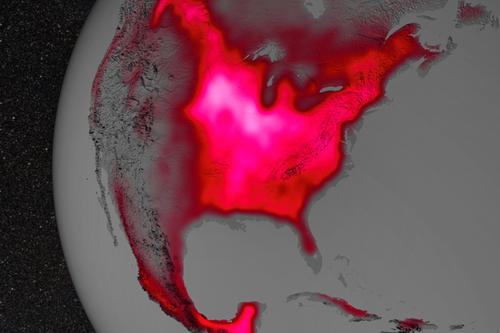Researchers from Freie Universität Berlin and NASA Measure Photosynthesis Activity
Recognizing at a glance how well the corn crop is growing in an entire region – and doing so from space, no less
Nov 10, 2014
Fluorescent fields: The photo shows a satellite image of North America, with the Corn Belt clearly visible as a light-colored area in the center of the continent.
Image Credit: JPL/NASA; NASA’s Goddard Space Flight Center
This is no longer a vague vision of the future, but instead a practical method developed by researchers at Freie Universität and scientists from the U.S. National Aeronautics and Space Administration (NASA). In one study, they used the method to show that the U.S. Midwest has the highest photosynthetic activity of any region on Earth.
The background? Healthy plants use photosynthesis to convert light into chemical energy. In this process, chlorophyll separates out a part of the radiation that it absorbs in the form of a fluorescent shine that is invisible to the human eye. The more photosynthesis takes place, the stronger the fluorescence. In turn, the study found that the intensity of the shine for a certain region is an “excellent indicator” of the rate of photosynthesis.
As early as 2011, studies conducted under the leadership of Joanna Joiner, of the NASA Goddard Space Flight Center, showed that the fluorescent radiation emitted by plants can be read from existing data from satellite measurements that were originally collected for other purposes, such as to find out about the composition of the atmosphere.
These results served as the basis for determining the rates of photosynthesis in agricultural areas in newer research headed by space scientists Luis Guanter and Yongguang Zhang of Freie Universität Berlin. The findings were published in March 2014 in the prestigious journal Proceedings of the National Academy of Sciences.
The study found that while the tropics have the highest productivity over the full year, the Corn Belt located in the U.S. Midwest is far more productive during the growth phase, in July. Fluorescence from the Corn Belt is even 40 percent stronger than in the rain forests of the Amazon “Areas all over the world are not as productive as this area,” writes co-author Christian Frankenberg of the NASA Jet Propulsion Laboratory, in Pasadena, California. Soil measurements confirmed the results of the satellite image analysis.
Since the satellite data produce only low-resolution images, the researchers have been limited so far to considering the productivity of large, homogeneous areas, including the vast tracts of land used for growing grain in the United States. Guanter and his colleagues are currently working to improve this.
Further Information
- Luis Guanter, Institute for Space Sciences, Freie Universität Berlin, Email: luis.guanter at wew.fu-berlin.de
- Yongguang Zhang, Institute for Space Sciences, Freie Universität Berlin, Email: yongguang.zhang at met.fu-berlin.de

